Get Valuable Customer Insights With MoEngage User Analysis
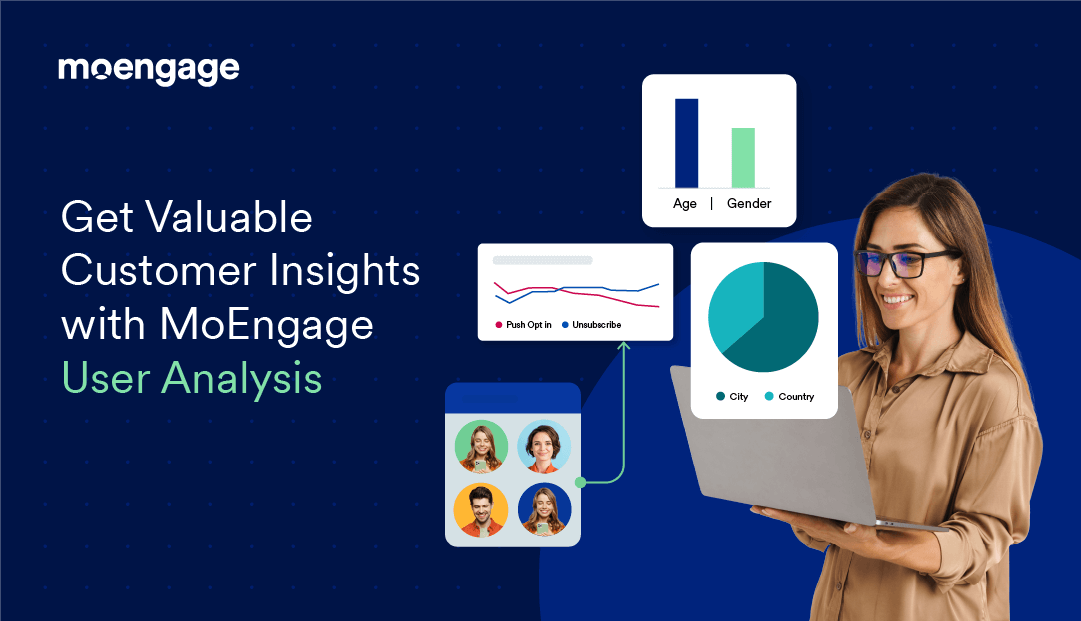
Reading Time: 8 minutes
In today’s competitive landscape, brands understand the power of personalization. A recent PWC report revealed that 78% of customers prefer to buy from brands offering personalized experiences.
However, creating truly personalized experiences for targeted audiences requires a deeper understanding of your customers. Beyond simply analyzing “what they do” (e.g., their purchase and engagement history), understanding “who they truly are” is crucial. This includes delving into their demographics, communication preferences, and other key characteristics.
Furthermore, consumer brands should aim to harness these audience insights to enhance and fine-tune their overall engagement strategy.
Nevertheless, many consumer brands struggle to gather and leverage these insights from customer data due to lack of efficient tools, or complexities in using them. This hinders their ability to identify trends, extract valuable trends, and ultimately make informed decisions.
To address this need, MoEngage has introduced another comprehensive yet user-friendly addition to its Analytics suite: User Analysis. Let’s explore how this tool empowers brands to analyze customers based on key characteristics.
Introducing User Analysis by MoEngage
User Analysis is a robust analytics tool that enables brands to deeply understand their customers based on their characteristics. By examining their demographics, preferences, credentials, and other attributes, brands can extract invaluable audience insights to drive impactful engagement and make data-driven decisions..
With a user-friendly interface, brands can effortlessly select desired customer attributes, filter them based on other attributes, perform a wide array of analyses, and visualize results using various charts for crystal-clear understanding.
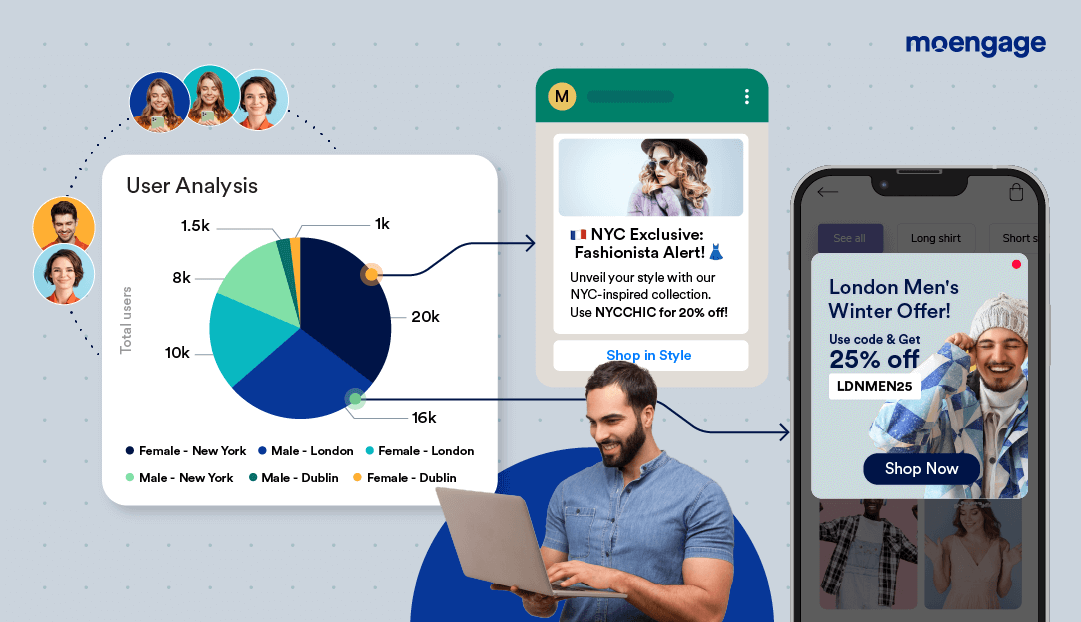
User Analysis enables brands to not just run analysis and gather insights, but act on them with just a click to drive desired action, whether it’s about driving impactful engagement, performing further analysis or more.
Overcoming Key Challenges
Modern-day brands aspire to delve deeper into understanding their customers beyond their actions, aiming to uncover the essence of “who they truly are” and “what they do.” This pursuit is driven by the desire to refine engagement strategies, enhance decision-making processes, identify novel customer segments, and foster more impactful engagement.
However, extracting these crucial insights from vast amounts of data poses significant challenges for brands, as outlined below:
1. Inability to Uncover Deep Audience Insights
Brands seek to analyze customers based on their key characteristics – demographics, preferences, credentials and other attributes – to identify key trends and extract deep insights. However, the lack of suitable capabilities in most Customer Experience Platforms (CEPs) or the limited functionalities offered by existing solutions hinders this endeavor.
2. Tedious Workarounds
The lack of a native tool forces brands to employ segmentation capabilities and/or external tools, leading to laborious processes involved in exporting data ( configuring if required) and then conducting analysis. This demands significant time and effort and introduces the inconvenience of using multiple tools.
3. Inability to Act on Insights Fast
Even after overcoming the hurdles to acquire insights, brands face challenges in swiftly acting upon them. Targeting the right audiences based on the insight discovered, requires creating a new segment from scratch or syncing these segments back to platform before engaging them. This impediment discourages marketers from proactively analyzing and engaging audiences.
4. Excessive Costs Associated with External Tools
The reliance on external tools for ‘analysis’, whether through data export or plugins, incurs unnecessary additional costs. Consequently, this impacts the return on investment for exploratory research and engagement efforts.
These challenges lead to missed opportunities for brands to leverage crucial audience insights for making informed, data-driven business decisions.
How User Analysis Resolves These Challenges
User analysis emerges as a one-stop solution, addressing these challenges head-on:
1. Uncovering Deeper Audience Insights
User Analysis enables brands to deeply analyze and understand their customers based on their key characteristics such as demographics, preferences, credentials and other lifecycle, acquisition, and uninstall attributes. Brands can seamlessly execute various analyses on multiple customer properties simultaneously, visualize results through vivid charts to get a clear understanding; and gather key audience insights.
2. Minimum Efforts with One Tool Does All
Brands can perform detailed User Analysis fast, and effortlessly using a single tool. It enables performing necessary analyses on required customer segments and gathering insights without depending on other tools. This consolidated approach eliminates the need for data synchronization, reducing time and effort required and ensuring a seamless customer experience.
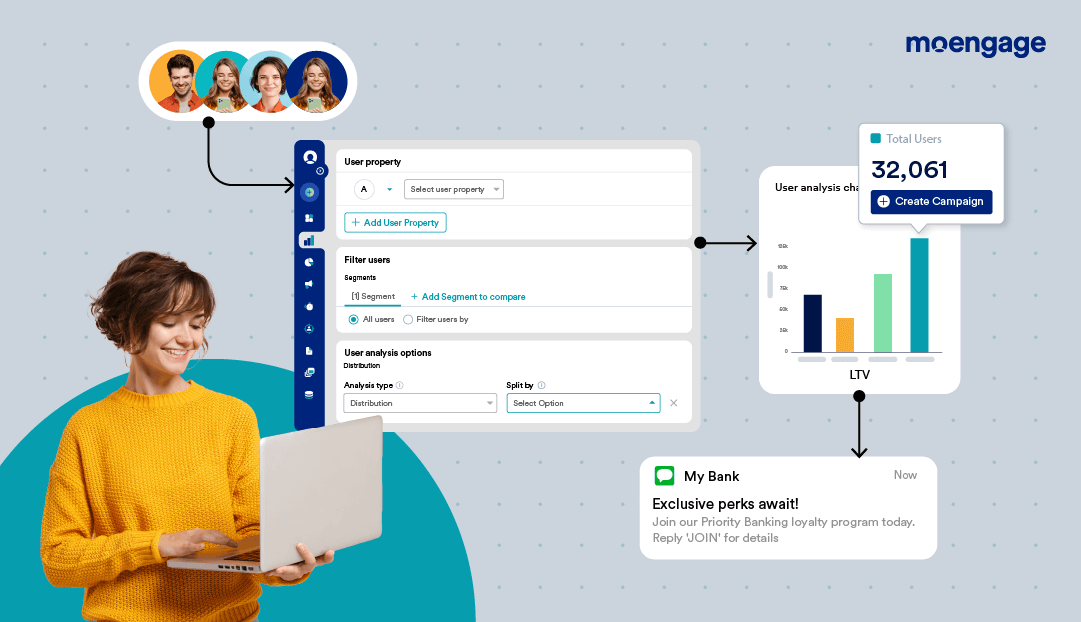
3. Swift Actionability with One-Click Functionality
User Analysis enables brands to not only visualize analysis results with clarity and also take immediate action with just a single click. Whether initiating a campaign, creating a segment, or conducting further analysis within segments, brands can swiftly respond based on key insights.
4. Cost Savings and Improved ROI
As part of the MoEngage Analytics suite, User Analysis is accessible at no extra cost. By eliminating reliance on external tools or platforms, not only it reduces expenses but also enhances the return on investment for both analysis and engagement efforts.
User Analysis emerges as a robust solution, streamlining the process of extracting actionable audience insights and empowering brands to make informed decisions efficiently and confidently.
What Sets User Analysis Apart
User Analysis distinguishes itself with its pioneering and unparalleled features, setting it apart from other analytics solutions in the market:
1. Breadth and Depth of Analysis
User Analysis offers a wide range of analysis types across diverse customer properties and stands out for its ability to facilitate in-depth exploration. With features that enable filtering and splitting analyses based on various customer attributes, brands can delve deep and extract crucial insights.
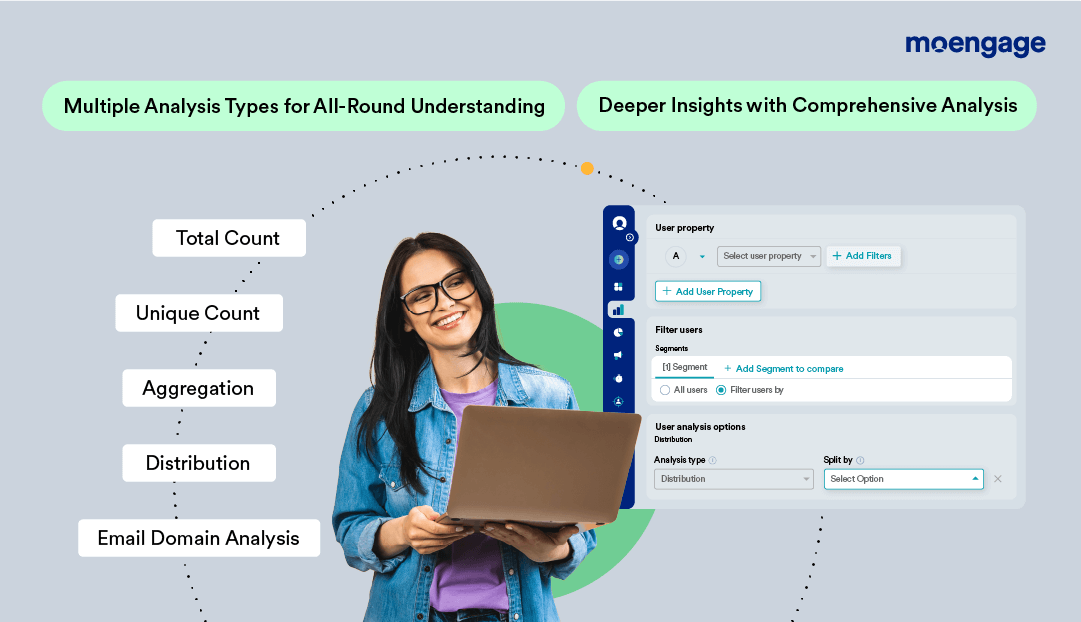
2. Powerful Visualization
User Analysis boasts powerful visualization capabilities, ensuring a clear understanding of each analysis. Whether it’s line charts, bar and column charts, pie charts, or specialized choropleth charts, consumer brands can visualize results seamlessly and transition between different visualization formats. This enhances comprehension, making it easier to identify trends and extract critical insights.
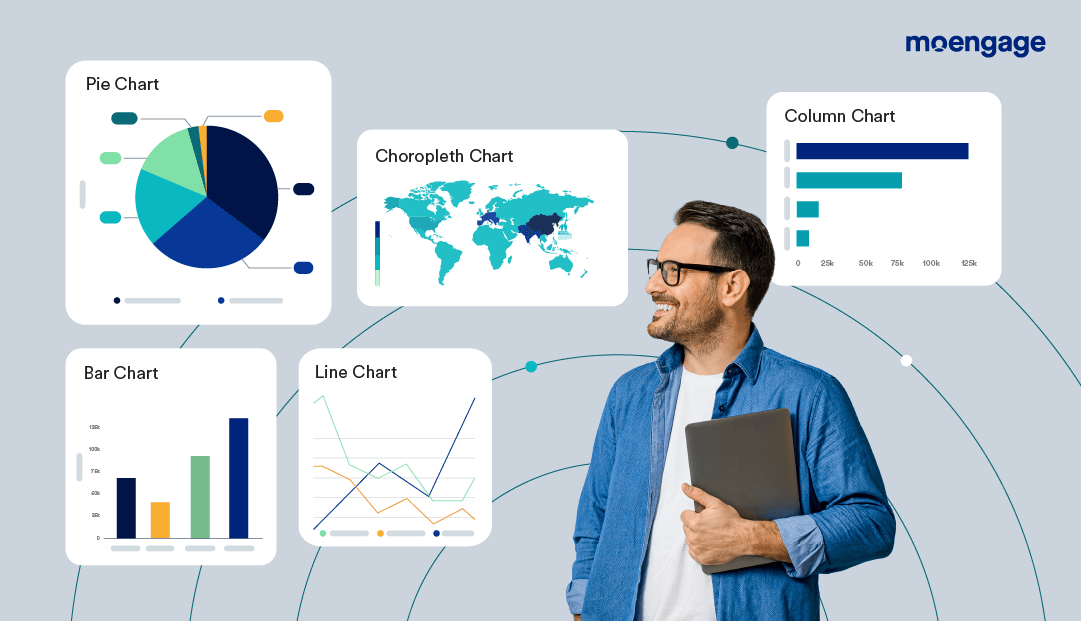
3. Synergy with Other MoEngage Capabilities
User Analysis seamlessly integrates with other MoEngage capabilities, unlocking a myriad of use cases –
- Custom Segments: Marketers can save insights as custom segments for further targetting
- Other Analysis: Marketer can conduct additional analyses such as Funnel analysis and Behavioral analysis on saved segments
- Engagement: Marketers can instantly engage segments identified from insights across all key channels
- Compare analysis: User analysis can be compared for multiple segments enabling discovery of critical trend and patterns better
This synchronization amplifies the overall effectiveness of User Analysis.
Leveraging User Analysis Across Industries
Brands across industries can harness user analysis to drive various business-critical use cases:
Retail/E-commerce
- A retail brand would want to analyze the web push subscription status of target audience for a particular region to understand and plan the engagement strategy, considering inclusion of web push channel for upcoming campaign
- A retail brand can analyze the geographical spread of its customers to understand which countries most of its customers belong to tailor its marketing efforts, localizing websites and campaigns along with the customer support service experience.
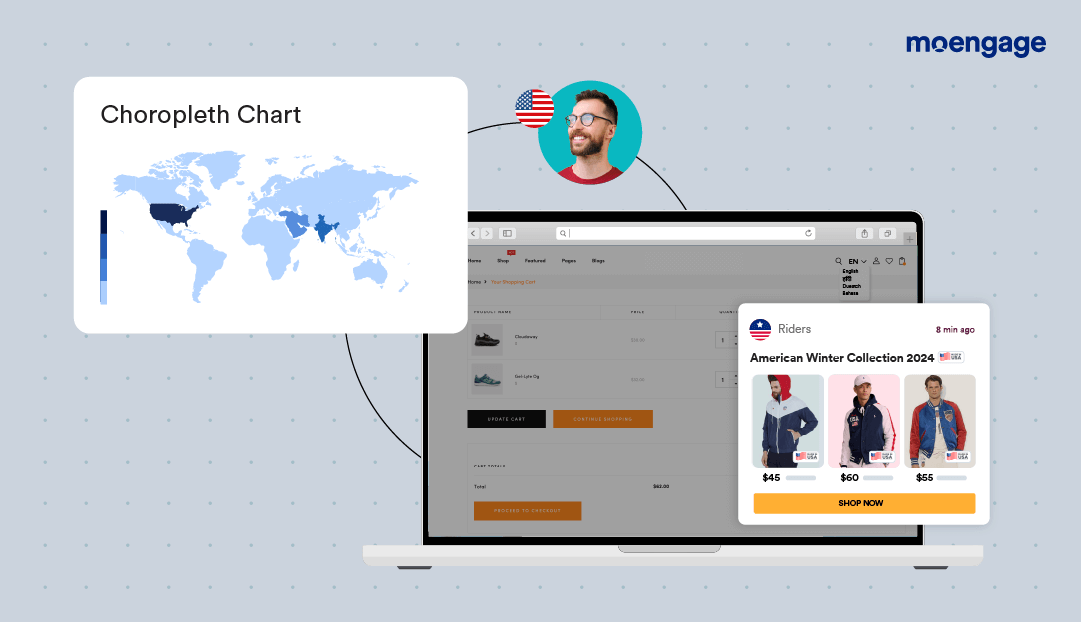
- An E-commerce company can analyze the lifetime value (LTV) of its top 25% customers, alongside understanding their demographics including age, gender, city, income, education, and more. This analysis helps identify key insights and patterns within its target parsona. By doing so, the company can refine its strategy regarding positioning, engagement, and new offerings.
BFSI
- A bank can analyze email domains to assess the common domains used by its users across different regions. By scrutinizing spam complaints and bounce rates associated with these domains, the bank can identify invalid emails, technical issues with domain servers, or recipients marking emails as spam. Based on these insights, the bank can take corrective actions to refine its email strategy and enhance engagement.
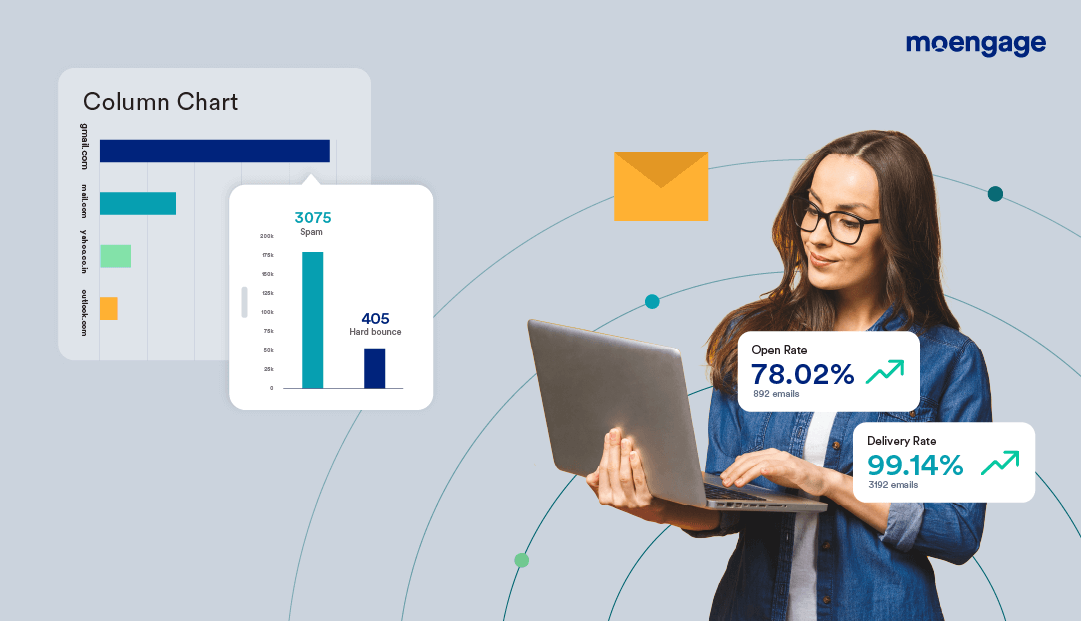
- A loan company can analyze push opt-in statuses across different regions to optimize engagement strategies for reminders and updates. Tailoring communication based on regional preferences ensures effective communication with diverse customer segments.
- A bank would want to understand the split of customers who accessed the website using mobile or web for availing micro-loans to better plan the launch strategy for the mobile app.
Media/OTT
- A Music Streaming app can analyze the peak uninstall times of the app such as day of the week/month, when customers uninstall the app the most. This analysis allows the brand to correlate uninstall trends like promotional offers, app updates, user engagement, maintenance downtime, and technical issues, and take corrective measures.
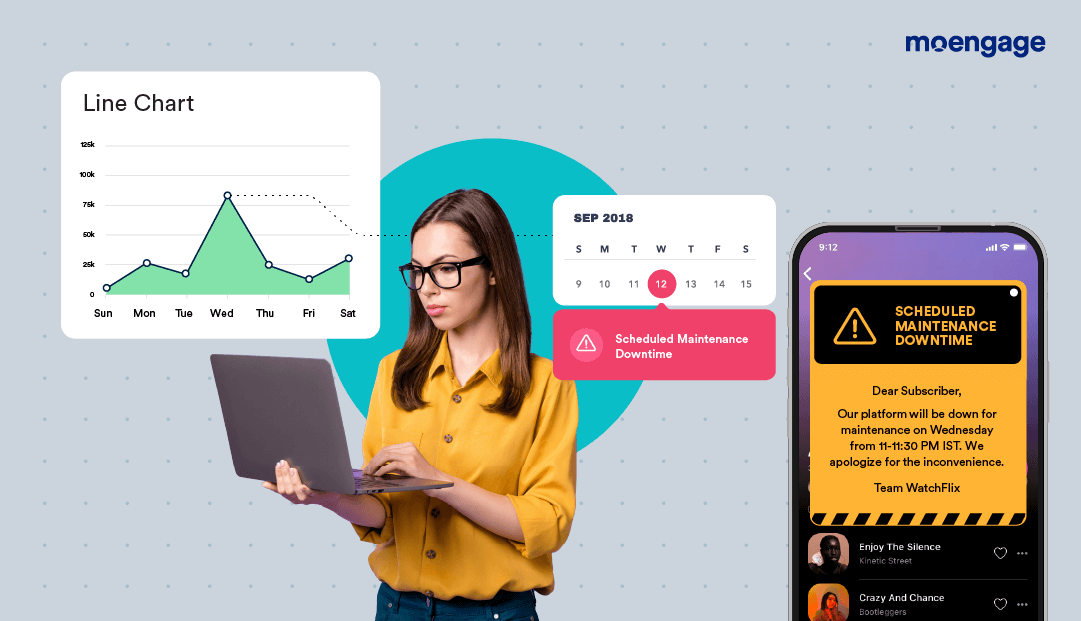
- An OTT brand can analyze the number of subscriptions from top customers, as a user can purchase multiple subscriptions, to plan its retention strategies better. The brand can achieve this by performing a unique count analysis of the users who have subscriptions, split by subscriptions.
- A video sharing platform may want to understand the number of subscriptions based on geographic locations. The platform can perform a distribution analysis based on the subscriptions and the last known city of the subscribers. This will help them understand which cities are performing the best and worst and then can drive engagement and offers accordingly.
Driving Impact with User Analysis
Empowered by User Analysis, brands can elevate decision-making and optimize strategies across various fronts:
1. Refined Segmentation and Targeting
By identifying high-value customer segments with optimal conversions and lifetime value (LTV), brands can refine existing customer segments and uncover new ones. This leads to more effective engagement, ultimately driving conversions.
2. Streamlined Acquisition and Growth
Leveraging customer onboarding insights, brands identify patterns such as the ideal onboarding timing and app install/uninstall status. This information optimizes acquisition campaigns, reducing customer acquisition costs.
3. Delightful Customer Experience
Utilizing insights into customer demographics and personal details, such as birthdays, enables brands to deliver hyper-personalized content, resulting in a delightful and tailored experience for users.
4. Enhanced Retention and Loyalty
By leveraging customer insights, including LTV and demographic details, brands can drive personalized engagement and tailored offers to retain high-value customers. This informs the design of loyalty programs aimed at fostering sustained customer loyalty..
5. Strategic Product and Promotion Planning
Brands can strategically utilize customer insights on demographics and preferences to develop products tailored to their needs. Additionally, understanding factors such as income, LTV, and spending patterns enables more effective planning of promotional offers, ensuring alignment with customer characteristics and optimizing overall engagement.
6. Increased Marketing ROI
Understanding customers’ channel preferences, opt-in status, and email suppression choices enables brands to identify the right channels and optimize engagement. This maximizes conversions, delivering a solid return on marketing investments.
User Analysis is a game-changer in understanding customer insights, enabling brands to dive deep into their customers’ personas and truly comprehend who they are. By harnessing these insights, brands can refine their engagement strategies, provide exceptional experiences, and build lasting customer relationships.
Ready to revolutionize your engagement efforts and drive key business metrics? Take the first step towards unlocking actionable audience insights by requesting a demo today.
To explore its functionalities and learn how to use it on the platform, visit our help docs for more information.














